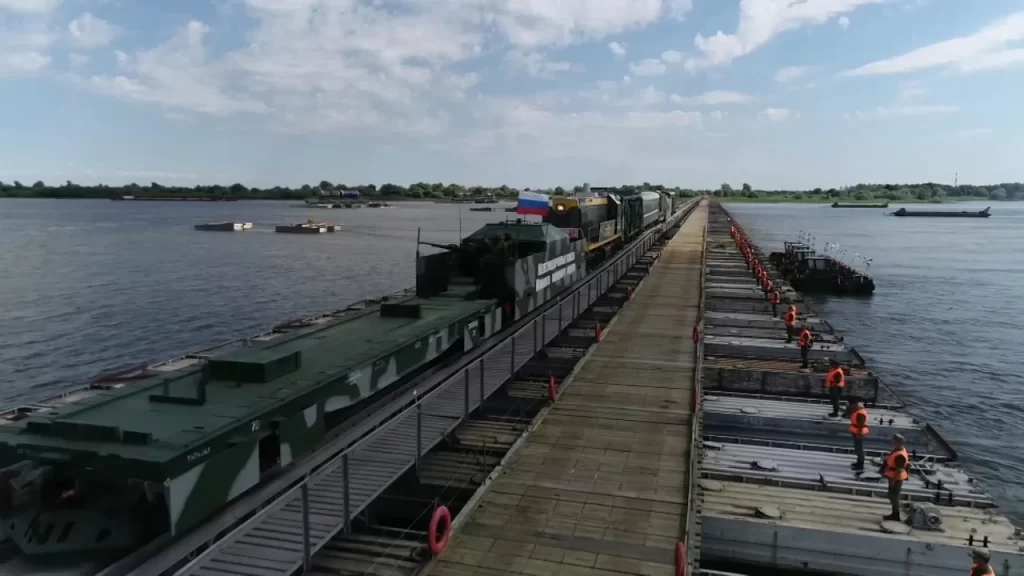Given the escalating tensions and the perceived likelihood of a conflict with NATO, Russia has opted to implement specialised railway forces as an element of the Northern Fleet. This strategic manoeuvre is intended to enhance the swift mobilisation of the Arctic region’s personnel, armament, and logistical assistance.
The efficient transportation of armament, fuel, and other critical materials to remote Arctic regions depends on these divisions. These units, equipped with Arctic-specific specialised equipment, are positioned to enhance Russia’s operational capabilities in the region.
According to sources familiar with the situation, establishing the first Arctic railway division last year established the foundation for forming comparable units.
The Russian Railway Troops honed their abilities in preparation for Arctic missions by gaining experience in difficult situations, such as the Baikal-Amur Mainline.
As per the Russian MoD, when constructing and operating railroads in the Arctic, numerous nuances must be taken into account. Despite this, the Russian railway staff has become acclimated to such circumstances. Their combat prowess has been previously showcased in the context of special military operations.
The development of railway infrastructure in the Arctic is a reaction to alterations in geopolitical dynamics, specifically the recent NATO membership of Finland, which has engendered apprehensions regarding security along Russia’s borders.
In order to ensure strategic preparedness and territorial defence, this urges the establishment of additional military formations and connections.
Regularly engaging in various technical exercises to ensure the security and functionality of railway infrastructure, Railway Troops maintain a presence in Ukraine despite ongoing combat operations. These operations include technical reconnaissance, railroad demining, erecting crossings, trash removal, and earthwork.
Specialised trains, including the “Baikal,” “Amur,” “Volga,” and “Yenisei,” are operated by railway troops. Servicing as escorts for military convoys and restoring railway tracks damaged during the conflict, these trains are vital.
Moreover, these specialised trains are equipped with weapons capable of countering terrestrial and aerial threats. The ZU-23-2 23mm anti-aircraft installations and the AGS-17 automatic grenade launchers are included in this configuration. Additionally, they possess electronic warfare equipment specifically engineered to incapacitate radio-controlled explosives. Furthermore, surveillance drones are integrated into the trains to facilitate the monitoring of movement routes.

The Russian Railway Troops
The Russian Railway Troops observed their 172nd inception anniversary on August 6, 2023. Railway Troops are a special forces division of the Material and Technical Support System of the Russian Armed Forces.
In support of the Russian Armed Forces, their combat utility is limited to technical cover, railway construction and maintenance, and the installation and operation of floating railway spans.
The Russian Ministry of Defence asserts that the Railway Troops are comprised of exceptionally skilled personnel outfitted with state-of-the-art technology and technical resources, enabling them to execute vital national obligations with efficacy and success.
Amidst the ongoing conflict between Russia and Ukraine, the Railway Troops provide critical logistical assistance to the primary railway lines that traverse military transit routes. Service members exhibit heroism and valour by performing valorous and heroic tasks such as demining and repairing damaged railway infrastructure, which allows military formations to proceed along trains uninterrupted.
On numerous occasions, the Railway Troops have been actively mitigating the consequences of natural and man-made catastrophes and addressing the populace’s social needs.
The Railway Troops are currently reconstructing the most arduous segment of the Baikal-Amur Mainline, spanning from the February station to the Ulak junction. The designated segment will involve more than 7 million cubic metres of earthwork, the reconstruction of 18 culverts, 118 sets of turnouts, and 48 bridges, and the construction of 111 kilometres of new railway lines.
The primary responsibility assigned to military railway personnel in 2023 was to finalise the primary subgrade construction works to facilitate the installation of the rail tie grid across nine sections. Approximately 1.9 million cubic metres of earthwork were completed, 30 kilometres of rail-tie grid were installed, and 22 sets of turnouts were in place by 2023. Currently, efforts are being made to reinforce the subgrade embankment, establish drainage channels, uphold access roads along the routes, backfill technical platforms, and undertake quarry excavation.
Railway Troops have participated in every significant military manoeuvre in recent years. Military railway personnel construct approach bridges and assembly bridges across bodies of water. Mind you, not just any water body; these are Russia’s principal tributaries. As an illustration, a pioneering floating bridge spanning three kilometres was constructed across the Volga River to facilitate the passage of military personnel throughout the 2019 exercises.
The condition of railway tracks and related infrastructure continues to be the Railway Troops’ foremost concern. Troops must restore these immediately and, more significantly, reestablish traffic in the region if any of them are destroyed. A portion of the equipment they receive is produced by the 192nd Bryansk Central Plant of Railway Equipment, an establishment that is among the earliest in the Russian Railway Troops system. Founded in 1919, the facility is owned by Rostec State Corporation’s Uralvagonzavod division. It provides the Railway Troops with specialised apparatus, such as machinery for pile-driving, track superstructure construction and maintenance, and bridge construction.
The organisation produces diverse railway equipment spanning track assembly platforms, mobile track layers, and universal track machines. The pile-driving apparatus Bryansk manufactured is operational in shallow and deep water. The floating railway bridge-tape MLZh-VF-VT manufactured by the plant is used across vast and deep water bodies. In conjunction with railroads, the IMZh-500 modular bridge-causeway permits the passage of tracked vehicles and automobiles.
